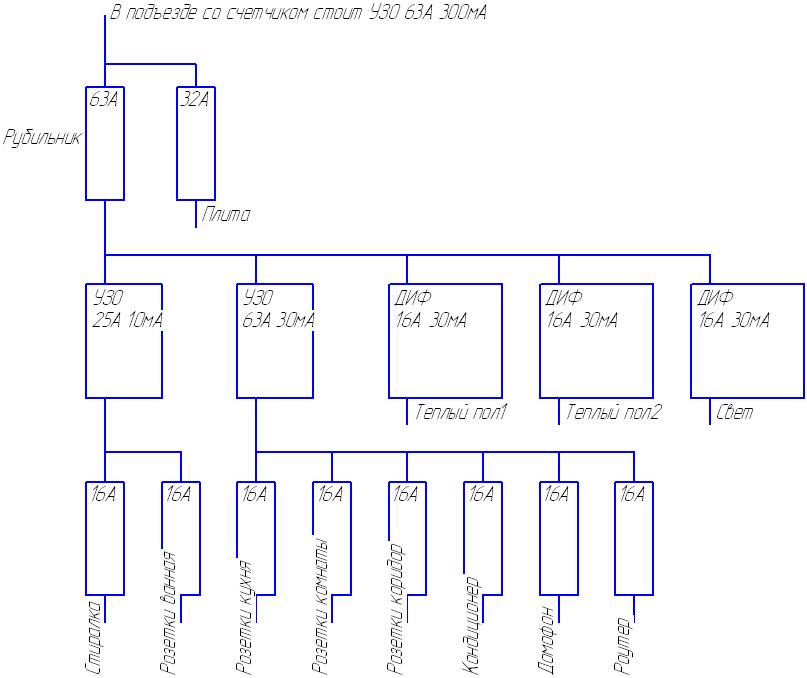Scheme of the electrical panel of a 2-room apartment
Hello! Redoing the wiring and shield of a 2-room apartment. There is not much experience (your site and technical education). I am attaching a shield drawing (I am waiting for a lot of stones in my garden.
Is such a shield scheme appropriate at all? If yes, then…
- Are the currents of the machines and RCDs selected correctly?
- Is it appropriate to use DIFs (left from the developer) on a warm floor and light?
- RCD what characteristics to use (AC, A)?
Thanks in advance!




1. For a warm floor, a difavtomat (or RCD + automatic machine) is needed, since this consumer is dangerous from the point of view of electric shock. A single machine will be enough for light, but you can leave a difavtomat - it will not be a mistake.
2. As for a separate machine for a washing machine - in this case it all depends on what load will be included in the sockets in the bathroom. If, in addition to the washing machine, another powerful electrical appliance, for example, a storage water heater, is switched on in the bathroom, then you need to install a separate machine.
3. RCD type A protects against AC leakage and surge current leakage. RCD type AC protects only against leakage of an alternating sinusoidal current. That is, it all depends on what electrical appliances this RCD protects. For electrical appliances having structurally power supplies, converters, various regulators, an RCD is required. Type A.
RCDs must be selected for a rated current that is one step higher than the rated current of the machines, if several machines are one step higher than the total rated current of the machines, since the machines do not turn off immediately when overloaded, and if you select the RCD for the same rating as the machine, then it may be subject to overload during operation.
As for the circuit as a whole, if you already have an RCD of 63 A at the input with the meter, then there is no need to put another RCD for several groups of consumers at the same value. It would be more correct to put separate RCDs on those lines that feed the most dangerous electrical appliances from the point of view of electric shock. That is, if such electrical appliances do not turn on on a particular line, then the RCD on this line does not need to be set. The RCD at the input performs a fire function, protecting the electrical wiring as a whole.
If you really have an UZO on the input, then you need to put the automatic machine on the input. You write a circuit breaker on the diagram, but you need a machine. Choose a machine based on the cross section of the input cable, the face value of the meter. In this case, the RCD must also be at a value higher than the input automatic machine.
Thank you so much for the answer. The management company at the time of writing this question has not yet given the keys to the electrical panel at the entrance. Information about the RCD at 63A (300 mA) (according to the management company) is incorrect. With a counter in the entrance is a 63A circuit breaker and a 50A differential switch (100mA).Do I understand correctly that by installing an RCD in the apartment on groups of sockets at 63A (30mA) to protect against electric shock, I observe the rule "RCD must be selected for the rated current, which is one step higher than the rated current of the input circuit breaker."
At the expense of the RCD rating. If you choose an RCD for input, then you choose its value above the value of the input machine. But if you already have a difavtomat at your input, then you do not need an RCD anymore, since the difavtomat performs the function of an RCD. For outlet groups, you select an RCD based on the rating of the machines that protect this outlet group. That is, you do not have to set the RCD to 63 A, you just need to put the RCD, which will be at par above the machine that protects this outlet group. For example, to protect one line with a 16 A circuit breaker, you select an RCD with a nominal value higher by 25 A. If, for example, you select an RCD to protect several groups of outlets, then take into account the total current of the circuit breakers on these lines. For example, two automatic machines of 16 A each are 32 A. You choose an RCD with a nominal value higher than 40 A. At the same time, you can set 63 A as well - it will not be an error.